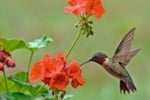COLUSA NATIONAL WILDLIFE REFUGE
Colusa National Wildlife Refuge is one of six refuges in the Sacramento Refuge Complex located in the Sacramento Valley of north-central California. The refuge is about 70 miles north of the metropolitan area of Sacramento.
The 4,507-acre refuge primarily consists of intensively managed wetland impoundments, with some grassland and riparian habitat. The Sacramento Valley is one of the most important wintering areas for waterfowl in North America. Colusa Refuge typically supports wintering populations of more than 200,000 ducks and 50,000 geese.
Wetland impoundments are intensively managed to provide optimal habitat for the dense concentration of wintering waterfowl, as well as habitat for resident wildlife and spring/summer migrants.
The grassland habitat supports several populations of endangered and sensitive species of plants. The refuge is a stronghold for populations of the endangered palmate-bracted bird's-beak and the threatened giant garter snake. About 35,000 visitors come to the refuge each year for wildlife viewing and 4,000 come to hunt waterfowl and pheasant.
The Valley is an extensive agricultural area that historically has been a major wintering area for millions of ducks and geese. Lands that surround the refuge are mostly irrigated rice land, with some wheat and orchards. Topography is flat with a gentle slope to the southeast towards the Sacramento River.
Colusa National Wildlife Refuge is located near Gridley, Live Oak and Roseville
Colusa NWR is part of the Sacramento NWR Complex located in the Sacramento Valley of northern California. The Refuge consists of over 4,500 acres comprised of seasonal marsh, permanent ponds, watergrass, and uplands.
The refuge was established in 1945 under the Authority of the Migratory Bird Treaty Act and the Lea Act. The Lea Act was passed to acquire habitat for migratory waterfowl and thereby alleviate severe crop losses experienced by rice growers.
Major objectives of the Refuge are: provide feeding and resting habitat for wintering waterfowl; provide habitat and manage for endangered, threatened or sensitive species; preserve a natural diversity and abundance of flora and fauna; alleviate crop depredation; and provide public use activities such as wildlife observation and hunting. The refuge is divided into 30 units, and wetlands comprise about 78% of the total acreage.
As wetlands of the Central Valley have been lost (95% over the past 100 years), the waterfowl resource has become increasingly dependent upon the refuges of the Sacramento Valley. The refuge typically supports wintering populations in excess of 200,000 ducks and 100,000 geese. As a result, the marsh management program is one of the most intensive in the refuge system.
Waterfowl are present September through March with peak populations occurring during December and January. Numerous birds and mammals are present year round.

BBs / Inns
Close to Calistoga, Napa Valley and Lake County Vineyards, and Harbin Hot Springs in the Mayacama Mountains, and 2 hrs away from San Francisco or Sacramento. Backyard Garden Oasis is an exquisite respite for those wanting a nature-filled retreat surrounded by some of Californias most beautiful country.
41.9 miles from park*
From Colusa, drive half a mile west on Highway 20 to the refuge entrance.
From Williams, exit Interstate 5 at Williams. Travel approximately 6 miles to graveled Ohair Rd. Travel south on graveled Ohair Road to the refuge entrance.



